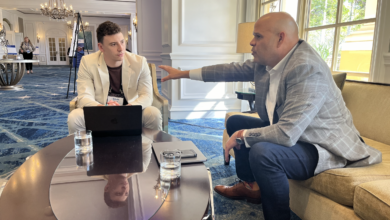
The Dependency Ratio and Ongoing Hotel Labor Challenges
By Larry and Adam Mogelonsky | December 13, 2022
By 2050, one-third of the population will be over the age of 65 in most of Western Europe, Japan, South Korea, New Zealand and a few others. Yes, that’s long way’s off; why care?
Well, demographic shifts of this nature aren’t like flipping on a light switch (or cyclical events like pandemics). They happen gradually, often at a glacial pace that only economists can accurately describe in hindsight. While this one-in-three stat is for 2050, expect to see this become an ever-present issue within a decade’s time. Knowing is half the battle, and now it’s time to pivot your business accordingly.
This burgeoning and global change to demography is what’s been catchily labeled as ‘The Silver Tsunami’, and it may usher in a prodigious new profit center for hotel brands that rivals or even exceeds rooms revenues, if these companies play their cards right. While your organization can go the route of medical tourism (people traveling specifically for a healthcare treatment with the hotel experience as secondary) or antiaging wellness (hotel experience primary with longevity programming as the auxiliary incentive), let’s discuss a third vertical that relies upon the ‘dependency ratio’.
A term ripped straight from economics textbooks, the dependency ratio describes a national or multinational percentage of the total citizenry that falls outside of the highly productive Working Age Population (WAP) – today defined roughly as ages 18 to 65 – and is thus ‘dependent’ on those in the WAP for all matter of sustenance, be it food production, shipping, manufacturing, software development or caregiving services. The higher the dependency ratio, the more strain there is on those left in the WAP to provide a great tax base to support public goods (like infrastructure projects, pension funds or hospitals) and the lower the overall supply of labor (which can in turn lead to sector-specific labor crises, salary inflation, commodity disruptions and numerous other macro-effects).
Within this broad definition are plenty of nuances as we pan the looking glass onto a specific country or issue related to aging:
- For various socioeconomic reasons, advanced economies are notorious for diminishing birth rates, meaning fewer ‘replacements’ into the WAP as aged workers exit via retirement
- While Japan has long been cited as the canary in the coalmine for what will happen to all other advanced economies, the Silver Tsunami is actually a global progression where emerging market economies are steadily taking advantage of modern medical advances in the form of better public healthcare systems to catch up to the West in terms of average lifespans, and this in turn is contributing to their citizens adopting ‘Western lifestyles’ which include lower birth rates
- A big issue with increasing lifespans is the rising incidence of ‘end stage diseases’ such as dementia, Alzheimer’s, Parkinson’s and other ailments that impair self-subsistence, thereby incentivizing WAP labor to shift to caregiving roles and straining supply for other industries
- Also important to any population graying and dependency ratio discussions is how the travel insurance industry will adjust their premiums to offer a non-prohibitive means for the majority of the elderly population to continue exploring the world (and not just the wealthy), particularly when framed according to the ‘economic gravity’ of not having as many WAP travelers available as prospective customers to sustain their revenues
- A declining WAP and the need for more ‘high touch, low skill’ caregivers will put increasing pressure on robotics and AI development in order to maintain domestic output and growth, not to mention the probability of sweeping changes to immigration policies in advanced economies
Always the optimists, the Silver Tsunami combined with the strides being made in longevity practices present vast and highly lucrative opportunities around the world to target local, regional and international guests for wellness experiences, with applicability for all hotel categories. This truly is an evergreen territory that any hotel company can investigate as a new source of long-term revenues.
Knowing that our planet is destined for a much higher dependency ratio above the present day, the question then is how do you prepare your hotel brand to profit from all this?
Focusing only on catering to dependents, there are plenty of opportunities in the near-term:
- Accessibility will become a primary determinant for hotel bookings, meaning that you need to adjust your messaging on the website, in marketing materials, in prearrival communications and through the retraining of chatbots in order to dispel concerns and raise booking confidence
- With the make-or-break nature of accessibility for many travelers’ purchasing decisions, some hotel companies may benefit by pivoting to become the brand of choice for this graying demographic, centering their offerings around ‘all accessible rooms’ where every guestroom or suite is configured with new amenities, safety features and IoT integrations that give peace of mind to the elderly, along with a myriad of value-added, on-demand caregiving services
- Also given the rising demand for caregivers, there’s an opening for new hotel brands that blend traditional guestroom and extended stay products with offerings more indicative of long-term care facilities so that specialized eldercare labor can be shared amongst the two verticals
- Building on the notion of chatbot and machine learning tools combined with the long-term dwindling of the WAP, hotels should start to investigate their options for robot workers to help offload the more rudimentary houseman and runner operations
- Rising dependency ratios can lead to increasing numbers of multigenerational travelers where working age guests bring along a senior family member (or other dependent) and will be influenced by onsite caregiving services, wellness programming targeted at the elderly, the ability to book adjoining rooms directly off the website and any packaging that mixes these together to offer more perceived value or convenience to the booker
With those five mentioned, hopefully it’s clear that every brand needs to map out their plan to capitalize on this global trend. To close, take a moment to consider the decades-long effects from the recently introduced ‘Time Bank’ concept in Switzerland where young people can volunteer by helping the elderly and thereby accrue ‘time credits’ for when they too are older. The dawn of the Silver Tsunami, and any resultant labor issues, is not a battle that hotels need fight alone; it is a challenge that all industries and businesses will face to varying degrees. Yet, as always, there are lucrative first-mover advantages to those hotel brands that start evolving their services and features for these dependent travelers.






Get involved!
Comments